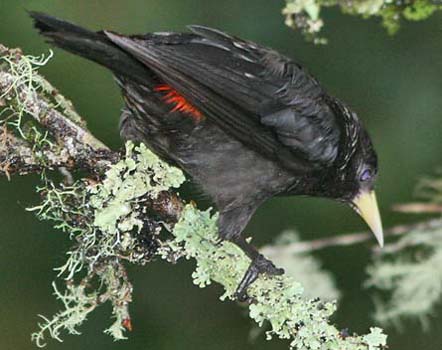TRIP LIST 30 July–2 Aug 2010
INTERVALES STATE PARK
Black-fronted Piping-Guan Pipile jacutinga: we had great looks at 2 birds one day, and 4 birds another day, feeding on palm fruits inside forest
Cattle Egret Bubulcus ibis: one at edge of park
Black Vulture Coragyps atratus: a few daily
Mantled Hawk Leucopternis polionotus: brief views of one in flight was all we got
White-rumped Hawk Percnohierax leucorrhous
: two birds watched at length as they called back and forth on our
first day (photos); this is a rarity here. We heard at least one daily
thereafter. Edson wondered if they were altitudinal migrants here at
this date
Roadside Hawk Buteo magnirostris: some had one each day
Short-tailed Hawk Buteo brachyurus: just one inside forest
Southern Caracara Caracara plancus: a few at edge of park
Yellow-headed Caracara Milvago chimachima: enroute to park only
Barred Forest-Falcon Micrastur ruficollis: one called in and seen perched our first day, at least one heard most days thereafter. The bird seen had a broad rusty collar
American Kestrel Falco sparverius: enroute to park only
Slaty-breasted Wood-Rail Aramides saracura: seen or heard each time we passed a small swamp
Southern Lapwing Vanellus chilensis: a couple on soccor field in park
Ruddy Ground-Dove Columbina talpacoti: enroute to park only
Rock Pigeon Columba livia: this non-native bird seen enroute to park only
Picazuro Pigeon Patagioenas picazuro: a few most days
Plumbeous Pigeon Patagioenas plumbea: a few most days
Eared Dove Zenaida auriculata: at edge of park only
Gray-fronted Dove Leptotila rufaxilla: one or two inside forest most days
Ruddy Quail-Dove Geotrygon montana: three flushed off ground during one hike, but not seen well
Maroon-bellied Parakeet Pyrrhura frontalis: up to 20/day
Blue-winged Parrotlet Forpus xanthopterygius: small groups occasionally
Plain Parakeet Brotogeris tirica: a few most days
Pileated Parakeet Pionopsitta pileata: a pair feeding in fig tree were seen well
Scaly-headed Parrot Pionus maximiliani: a few most days
Smooth-billed Ani Crotophaga ani: enroute to park only
Pavonine Cuckoo Dromococcyx pavoninus: we had great close encounters with two different perched birds
Tropical Screech-Owl Megascops choliba: pair had a day roost at headquarters; also heard nightly
Rusty-barred Owl Strix hylophila: a pair on territory was called once for good views (heard another night at same spot)
Burrowing Owl Athene cunicularia: enroute to park only
Long-trained Nightjar Macropsalis forcipata: at dusk on a clear day we watched an adult male in courtship flights, and resting on road between flights
White-collared Swift Streptoprocne zonaris: small flock overhead one day
Dusky-throated Hermit Phaethornis squalidus: a few most days
Scale-throated Hermit Phaethornis eurynome: a bit more common than previous species
Swallow-tailed Hummingbird Eupetomena macroura: singles on a couple of days
Plovercrest Stephanoxis lalandi: one male appeared briefly near the makeshift feeder at our lodging
Festive Coquette Lophornis chalybeus: male foraging in canopy inside forest, returning to same perch for distant photos
Violet-capped Woodnymph Thalurania glaucopis: up to a half-dozen daily
White-throated Hummingbird Leucochloris albicollis: only a few encountered
Green-backed Trogon Trogon viridis: now split from White-tailed Trogon; males seen on two days
Surucua Trogon Trogon surrucura: singles daily, each a different bird in different spot
Black-throated Trogon Trogon rufus: one seen our first day, a couple more heard
Rufous-capped Motmot Baryphthengus ruficapillus: up to 4/day but only a couple were seen
Crescent-chested Puffbird Malacoptila striata: one male approached closely well out Carmo Road
Red-breasted Toucan Ramphastos dicolorus: heard daily but only one seen here
Ochre-collared Piculet Picumnus temminckii: a few seen every day
Yellow-fronted Woodpecker Melanerpes flavifrons: up to 3/day but patchy
White-spotted Woodpecker Veniliornis spilogaster: one was seen or heard every day
Yellow-browed Woodpecker Piculus aurulentus: one female at feeder was seen a couple of times
Campo Flicker Colaptes campestris: a few at edge of park
Olivaceous Woodcreeper Sittasomus griseicapillus: the common woodcreeper, 3-6/daily
Planalto Woodcreeper Dendrocolaptes platyrostris: singles on a couple of days seen
Scalloped Woodcreeper Lepidocolaptes falcinellus: singles on a couple of days with mixed flocks
Black-billed Scythebill Campylorhamphus falcularius: one in a mixed flock out Carmo Road was seen briefly; another heard
Rufous-breasted Leaftosser Sclerurus scansor: heard daily but a real struggle to see
Rufous Hornero Furnarius rufus: a pair hung out by dining hall
Rufous-capped Spinetail Synallaxis ruficapilla: fairly common but only a couple seen
Pallid Spinetail Cranioleuca pallid: heard daily but only a few seen around our lodging
White-browed Foliage-gleaner Anabacerthia amaurotis: one in mixed flock seen
Buff-browed Foliage-gleaner Syndactyla rufosuperciliata: Edson heard it daily in flocks; one poor glimpse was my only view
Ochre-breasted Foliage-gleaner Philydor lichtensteini: one seen decently in canopy flock on final day
Buff-fronted Foliage-gleaner Philydor rufum: a regular component of canopy flocks
White-collared Foliage-gleaner Anabazenops fuscus: also regular in mixed flocks, and easier to see than most foliage-gleaners
Pale-browed Treehunter Cichlocolaptes leucophrus: heard a couple of times, and one untickable view in a huge canopy flock
White-eyed Foliage-gleaner Automolus leucophthalmus: a couple in mixed flocks, only one seen decently
Sharp-tailed Streamcreeper Lochmias nematura: Edson heard it daily, but only Dan & Don got a great view in the rain as one strolled across a log in a swamp
Sharp-billed Treehunter Heliobletus contaminates: singles seen nicely in flocks our final two days
Streaked Xenops Xenops rutilans: one in a mixed flock our first day was it
Spot-backed Antshrike Hypoedaleus guttatus: one fine view on Lageado trail
Giant Antshrike Batara cinerea: this highly desired bird heard most days but only one female seen, and that right near our lodging in low scrub
Large-tailed Antshrike Mackenziaena leachii: a single male seen was our only encounter with this much-wanted bird
Tufted Antshrike Mackenziaena severa: another much-wanted species, and several heard, but just one male seen along Lageado trail
White-bearded Antshrike Biatas nigropectus: this specialized endemic was seen twice – a male one day and a pair in bamboo well out Carmo Road another day
Variable Antshrike Thamnophilus caerulescens: several pairs daily, including a pair that lived next to our lodging
Plain Antvireo Dysithamnus mentalis: up to 4/daily; this taxon is very different than Plain Antvireos in Central America and most surely be a different species
Star-throated Antwren Myrmotherula gularis: heard daily but hard to see in thick undergrowth; Edson called in several with tapes for photo attempts
Ferruginous Antbird Drymophila ferruginea: one male seen, others heard, but a skulker
Streak-capped Antwren Terenura maculate: a tiny bird of the canopy, very hard to see, but heard or glimpsed daily
White-shouldered Fire-eye Pyriglena leucoptera: several heard daily but a real skulker in dark shady undergrowth, and views generally quick or poor
Squamate Antbird Myrmeciza squamosa: heard daily in undergrowth, and pairs sometimes responded well to tape
Rufous-capped Antthrush Formicarius colma: one seen exceptionally well as in walked through forest along Lageado Trail, responding to tape
Short-tailed Antthrush Chamaeza campanisona: heard daily inside forest but very tough to see; one eventually responded to tape for views at dusk in the rain
Rufous Gnateater Conopophaga lineate: great little bird heard daily, and seen several times with tape
Black-cheeked Gnateater Conopophaga melanops: one responded well to Edson’s tape along the Lageado trail for close but quick views (Dan & Don only)
Spotted Bamboowren Psilorhamphus guttatus: a calling male was seen well inside bamboo thicket, in response to tape, on Mirante trail; see Threatened birds page for photo
Slaty Bristlefront Merulaxis ater:
an incredible male responded exceptionally to Edson’s tape at road edge
not far from headquarters. Edson set the tape down under a cleared spot
with a single branch left – the bird walked across the branch and
hopped onto the tape recorder; it also circled us several times, even
daring to dash across the road
Serra do Mar Tapaculo Scytalopus (speluncae) notorious:
a recent split from Mouse-colored Tapaculo S. speluncae, one was seen
well with tape at road edge. More were heard on other days; Edson says
it sounds different here than at Itatiaia and should perhaps be split
again
Gray-hooded Flycatcher Mionectes rufiventris: up to 4/daily, sometimes around our lodging
Sepia-capped Flycatcher Leptopogon amaurocephalus: failry common in canopy flocks but hard to see well
Hangnest Tody-Tyrant Hemitriccus nidipendulus: one was in a small flock just as we arrived at our lodging, and not seen again
Ochre-faced Tody-Flycatcher Poecilotriccus plumbeiceps: seen or heard daily in small numbers
Planalto Tyrannulet Phyllomyias fasciatus: the most easily seen of the many similar tyrannulets, as it tended to stay low and at edge of forest; up to 4/daily
Gray-capped Tyrannulet Phyllomyias griseocapilla: a couple were seen well near our lodging
Gray Elaenia Myiopagis caniceps: one in a canopy flock out Carmo Road
Southern Beardless-Tyrannulet Camptostoma obsoletum: a couple in more open areas
Sao Paulo Tyrannulet Phylloscartes paulista: a couple seen in a canopy flock but more at mid-levels in tree; we’d never have found it without Edson
Oustalet's Tyrannulet Phylloscartes oustaleti:
possibly the most common of the small tyrannulets in canopy flocks, and
easily picked out by its gnatcatcher-like tail-waving behavior
Bay-ringed Tyrannulet Phylloscartes sylviolus: a high canopy species, seen or heard most days in small numbers, but very difficult to see upperparts
Eared Pygmy-Tyrant Myiornis auricularis: rather common along some trails and not really a flock bird but very active at forest edge
Yellow-olive Flycatcher Tolmomyias sulphurescens: seen or heard daily in small numbers; looks different than birds elsewhere in the Neotropics (a possible split?)
Cliff Flycatcher Hirundinea ferruginea: just one in this park
Streamer-tailed Tyrant Gubernetes yetapa: enroute to park only
Shear-tailed Gray Tyrant Muscipipra vetula: one seen in a mixed canopy flock
Long-tailed Tyrant Colonia colonus: a couple on several days in canopy flocks
Social Flycatcher Myiozetetes similis: not common here although Edson heard more than we saw
Great Kiskadee Pitangus sulphuratus: small numbers daily
Three-striped Flycatcher Conopias trivirgatus: could be patchily common in canopy flocks
Sirystes Sirystes sibilator: singles on a couple days, and apparently the leader of some canopy flocks
Gray-hooded Attila Attila rufus: one called in from canopy well out Carmo Road
Sharpbill Oxyruncus cristatus:
this much wanted species was quite scarce; indeed, we saw just one bird
but it came to a fruiting tree by our lodging almost every day
Hooded Berryeater Carpornis cucullata: pairs out Carmo Road every time we went there; see Threatened birds page for photo
Bare-throated Bellbird Procnias nudicollis: one or more males heard in the distance every day but never close enough to chase; we did not see the species until Itatiaia
Cinnamon-vented Piha Lipaugus lanioides: one seen in canopy out Carmo Road
Wing-barred Piprites Piprites chloris: one seen on our first afternoon was it
Pin-tailed Manakin Ilicura militaris: Edson heard it most days; we saw a couple females only
Blue Manakin Chiroxiphia caudate: several males heard daily but only a couple of females seen
Greenish Schiffornis Schiffornis virescens:
several heard daily but hard to see; birds were very responsive to tape
and zinging by us in flight, but did not often perch in view
Chestnut-crowned Becard Pachyramphus castaneus: one or two most days in mixed canopy flocks
Black-capped Becard Pachyramphus marginatus: one showed well out Carmo Road
Rufous-browed Peppershrike Cyclarhis gujanensis: a few heard or seen most days
Rufous-crowned Greenlet Hylophilus poicilotis: one seen near our lodging; Edson heard more
Curl-crested Jay Cyanocorax cristatellus: enroute to park only
Blue-and-white Swallow Pygochelidon cyanoleuca: small flock one day
Southern House-Wren Troglodytes [a.] musculus: one daily near our lodging
Rufous-bellied Thrush Turdus rufiventris: a few every day, including at feeder
White-necked Thrush Turdus albicollis: seen in canopy several times, and one came to our makeshift feeder for some
Chalk-browed Mockingbird Mimus saturninus: enroute to park only
Tropical Parula Parula pitiayumi: not uncommon but scattered
Golden-crowned Warbler Basileuterus culicivorus: fairly common daily in undergrowth flocks
White-rimmed Warbler Basileuterus leucoblepharus: heard most days; pairs seen very well once during a rainstorm
Riverbank Warbler Phaeothlypis rivularis: a couple seen at marsh edge
Bananaquit Coereba flaveola: not common but heard or seen daily by someone
Brown Tanager Orchesticus abeillei:
a daily component of mixed species flocks, often same flock at
Chestnut-crowned Becard; also skuled in scrub around our lodging
Magpie Tanager Cissopis leverianus: a couple out Carmo Road
Olive-green Tanager Orthogonys chloricterus: common in often pure flocks in canopy, and readily attracted to the feeder
Black-goggled Tanager Trichothraupis melanops: fairly common; up to 12/day
Ruby-crowned Tanager Tachyphonus coronatus: fairly common daily, and attracted to feeder
Sayaca Tanager Thraupis sayaca: a couple recorded at feeder but most were likely overlooked
Azure-shouldered Tanager Thraupis cyanoptera: daily at feeder (up to 12/day) but not elsewhere
Golden-chevroned Tanager Thraupis ornate: fairly common, esp. at our feeder
Diademed Tanager Stephanophorus diadematus: two in a large mixed species flock near our lodging
Green-headed Tanager Tangara seledon: common at the feeder and along forest edge
Red-necked Tanager Tangara cyanocephala: patchy in tanager flocks, but never at feeder
Brassy-breasted Tanager Tangara desmaresti: a lovely tanager that was recorded daily in good weather but never at feeder
Chestnut-backed Tanager Tangara preciosa: one female at our feeder a couple of days
Black-legged Dacnis Dacnis nigripes: one seen by Edson & Don in mixed tanager flock near lodging
Black-throated Grosbeak Saltator fuliginosus: one taped in well out Carmo Road
Green-winged Saltator Saltator similis: small numbers daily, and regular at feeder
Rufous-collared Sparrow Zonotrichia capensis: a pair was resident at our lodging
Uniform Finch Haplospiza unicolor: rather common forest edge bird at some spots
Gray-throated Warbling-Finch Poospiza cabanese: found on two days but rather active
Red-crowned Ant-Tanager Habia rubica: pair in understory well out Carmo Road
Red-rumped Cacique Cacicus haemorrhous: mostly seen at our feeder (up to 5/day)
Golden-winged Cacique Cacicus chrysopterus: fairly common in small flocks, and regular at our feeder
Chopi Blackbird Gnorimopsar chopi: enroute to park only
Yellow-rumped Marshbird Pseudoleistes guirahuro: enroute to park only
Chestnut-bellied Euphonia Euphonia pectoralis: a couple daily, often at feeder
House Sparrow Passer domesticus: non-native seen enroute to park only
Birds
that were heard/seen by our guide only, plus a few birds we all heard
but which would have been lifers if seen (e.g., tinamou, antpitta,
Helmeted Woodpecker): Brown Tinamou Crypturellus obsoletus, Spot-winged Wood-Quail Odontophorus capueira, Blackish Rail Pardirallus nigricans, Blue-bellied Parrot Triclaria malachitacea, Least Pygmy-Owl Glaucidium minutissimum, Gray-rumped Swift Chaetura cinereiventris, Versicolored Emerald Amazilia versicolor, Brazilian Ruby Clytolaema rubricauda, Spot-billed Toucanet Selenidera maculirostris, Helmeted Woodpecker Dryocopus galeatus [pair heard calling but across a deep canyon from us, and they did not come in to tape], White-throated Woodcreeper Xiphocolaptes albicollis, Lesser Woodcreeper Xiphorhynchus fuscus, Chicli Spinetail Synallaxis spixi, Orange-eyed Thornbird Phacellodomus erythrophthalmus, Bertoni's Antbird Drymophila rubricollis, Ochre-rumped Antbird Drymophila ochropyga, Dusky-tailed Antbird Drymophila malura, Variegated Antpitta Grallaria varia, White-breasted Tapaculo Scytalopus indigoticus, Brown-breasted Bamboo-Tyrant Hemitriccus obsoletus, Yellow-lored (Gray-headed) Tody-Flycatcher Todirostrum poliocephalum, Rough-legged Tyrannulet Phyllomyias burmeisteri, White-throated Spadebill Platyrinchus mystaceus,White-rumped Swallow Tachycineta leucorrhoa, Grey-breasted Martin Progne chalybea, Long-billed Gnatwren Ramphocaenus melanurus, Blue Dacnis Dacnis cayana, Rufous-headed Tanager Hemithraupis ruficapilla, Buffy-fronted Seedeater Sporophila frontalis, Double-collared Seedeater Sporophila caerulescens, and Shiny Cowbird Molothrus bonariensis.
For mammals, see my Mammals two-page set. I am still sorting out our Herps (amphibians & reptiles) and Odes (dragonflies). |
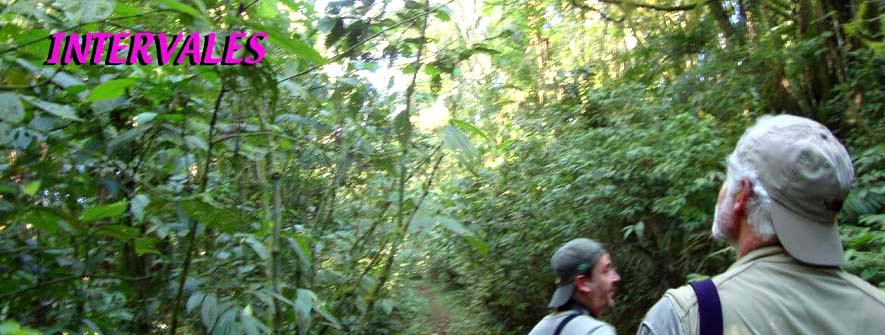

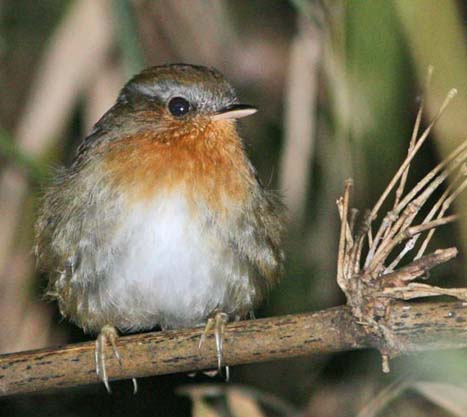

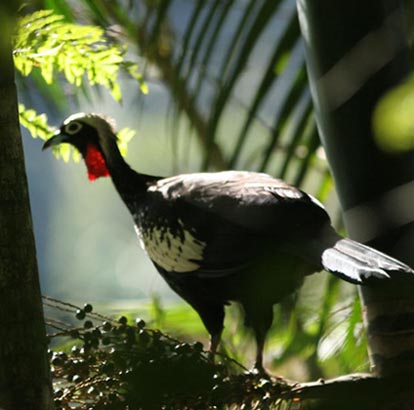
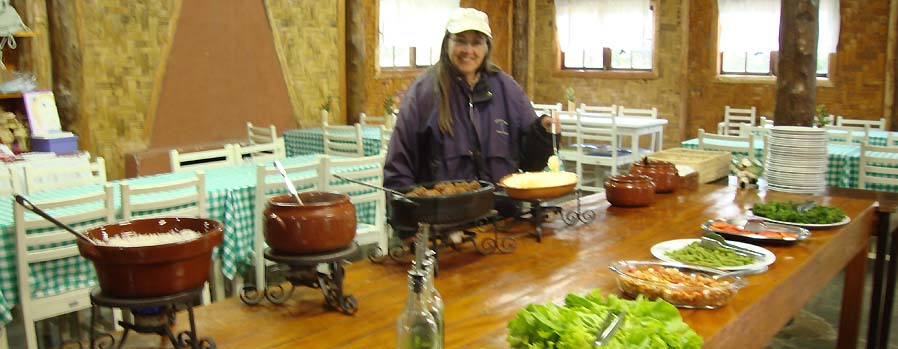
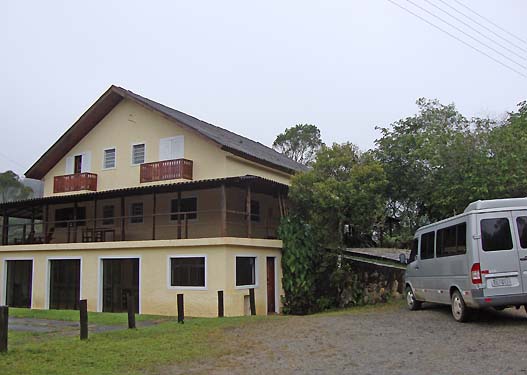 There
were very few other park visitors here between 30 July–2 August, and we
often had the entire lunch or dinner buffet (above) to ourselves. We
also had an entire lodging house (called Pica-Pau, right; that's the
van we used for transport as well). The forest starts just to the right
of this photo; a garden and a fruiting tree are to the left (that tree
hosted the Sharpbill). Our schedule was:
There
were very few other park visitors here between 30 July–2 August, and we
often had the entire lunch or dinner buffet (above) to ourselves. We
also had an entire lodging house (called Pica-Pau, right; that's the
van we used for transport as well). The forest starts just to the right
of this photo; a garden and a fruiting tree are to the left (that tree
hosted the Sharpbill). Our schedule was:

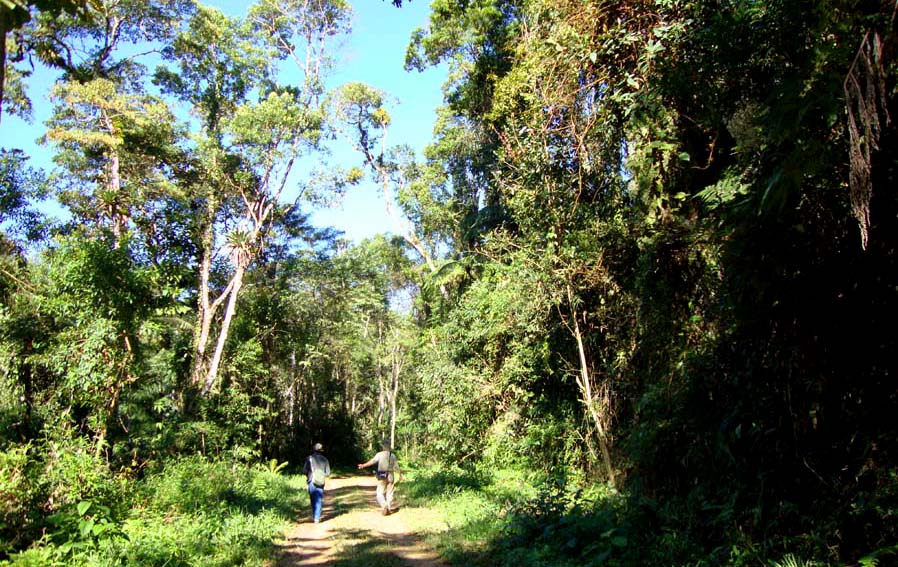
 When the sun shines, the forest is spectacular here (above; out Carmo Road). On consecutive days we found a perched Pavonine Cuckoo that allowed close approach (right). On our first day Edson found a calling pair of White-rumped Hawk (one calling, below). This is a very scarce species and not often photographed.
When the sun shines, the forest is spectacular here (above; out Carmo Road). On consecutive days we found a perched Pavonine Cuckoo that allowed close approach (right). On our first day Edson found a calling pair of White-rumped Hawk (one calling, below). This is a very scarce species and not often photographed. 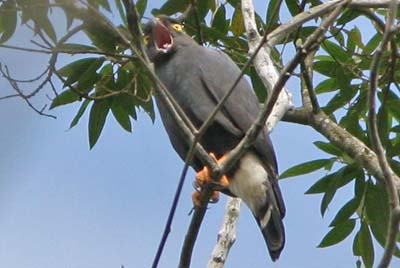

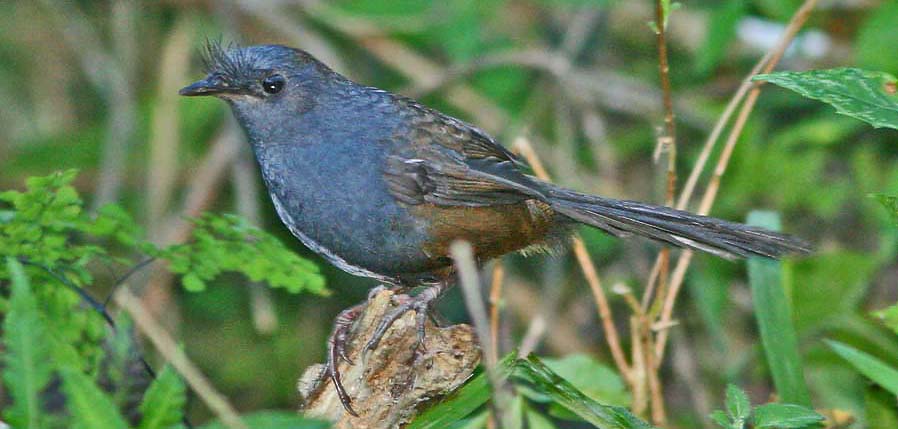
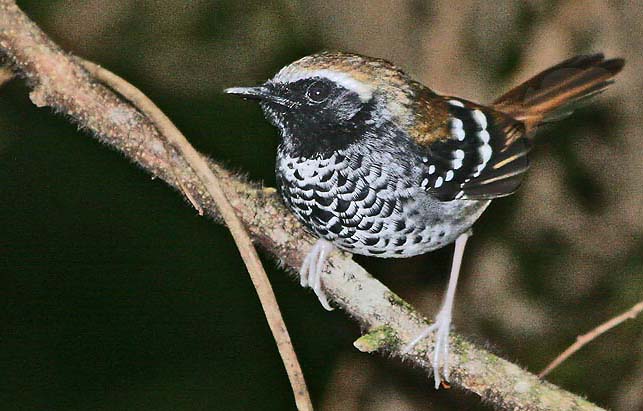 Working with Edson we got unbelievable views of inveterate skulkers like Squamate Antbird (male, right) and perhaps best of all, Slaty Bristlefront (above).
Working with Edson we got unbelievable views of inveterate skulkers like Squamate Antbird (male, right) and perhaps best of all, Slaty Bristlefront (above). 
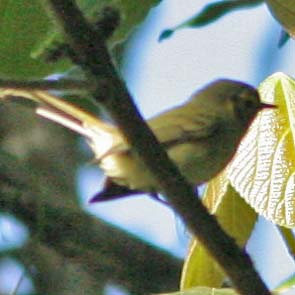

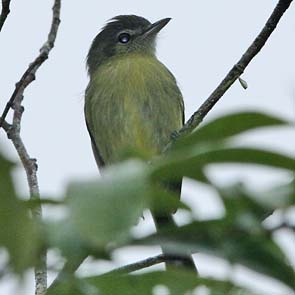
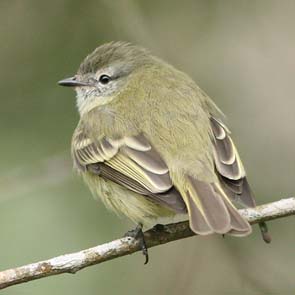

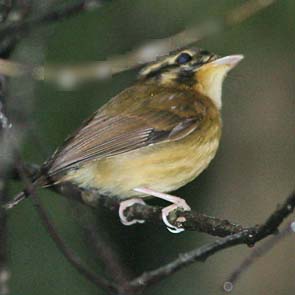

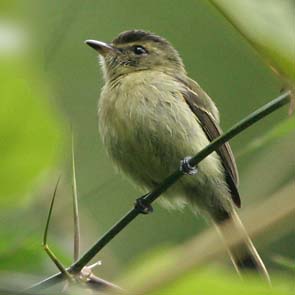
 When
the rains came and washed out a morning's birding, Edson just made the
most of it. He created a makeshift bird feeder outside our lodge with
logs, limbs, bread, and bananas (below).
When
the rains came and washed out a morning's birding, Edson just made the
most of it. He created a makeshift bird feeder outside our lodge with
logs, limbs, bread, and bananas (below).
